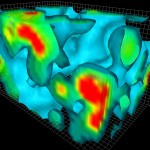In this video from PASC18, Constantia Alexandrou from the University of Cyprus discusses her domain of expertise – quantum chromodynamics. “Many – if not most – fields in physics employ high performance computing, yet quantum chromodynamics (QCD) might be the premiere example of an area very difficult to understand outside of the field.”
The Colourful Theory: Visible and Invisible Matter in the Universe
“Chromodynamics helps us understand our universe. The strong interaction is one of the four forces describing complex phenomena in the evolution of the universe from the quark gluon plasma formed just after the Big Bang at the birth of the cosmos to the formation of neutron stars. The bulk of visible matter in the universe is due to the strong interaction and understanding its properties requires the solution of quantum chromodynamics (QCD).”
SciDAC funding to Move Quantum Chromodynamics forward at Jefferson Lab
As nuclear physicists delve ever deeper into the heart of matter, they require the tools to reveal the next layer of nature’s secrets. Nowhere is that more true than in computational nuclear physics. A new research effort led by theorists at DOE’s Jefferson Lab is now preparing for the next big leap forward in their studies thanks to funding under the 2017 SciDAC Awards for Computational Nuclear Physics.
QCD Optimization on Intel Xeon Phi
“Many optimizations can be performed on an application that is QCD based and can take advantage of the Intel Xeon Phi coprocessor as well. With pre-fetching, SMT threading and other optimizations as well as using the Intel Xeon Phi coprocessor, the performance gains were quite significant. An initial test, using single precision on the base Sandy Bridge systems, the test case was showing about 128 Gflops. However, using the Intel Xeon Phi coprocessor, the performance jumped to over 320 Gflops.”







